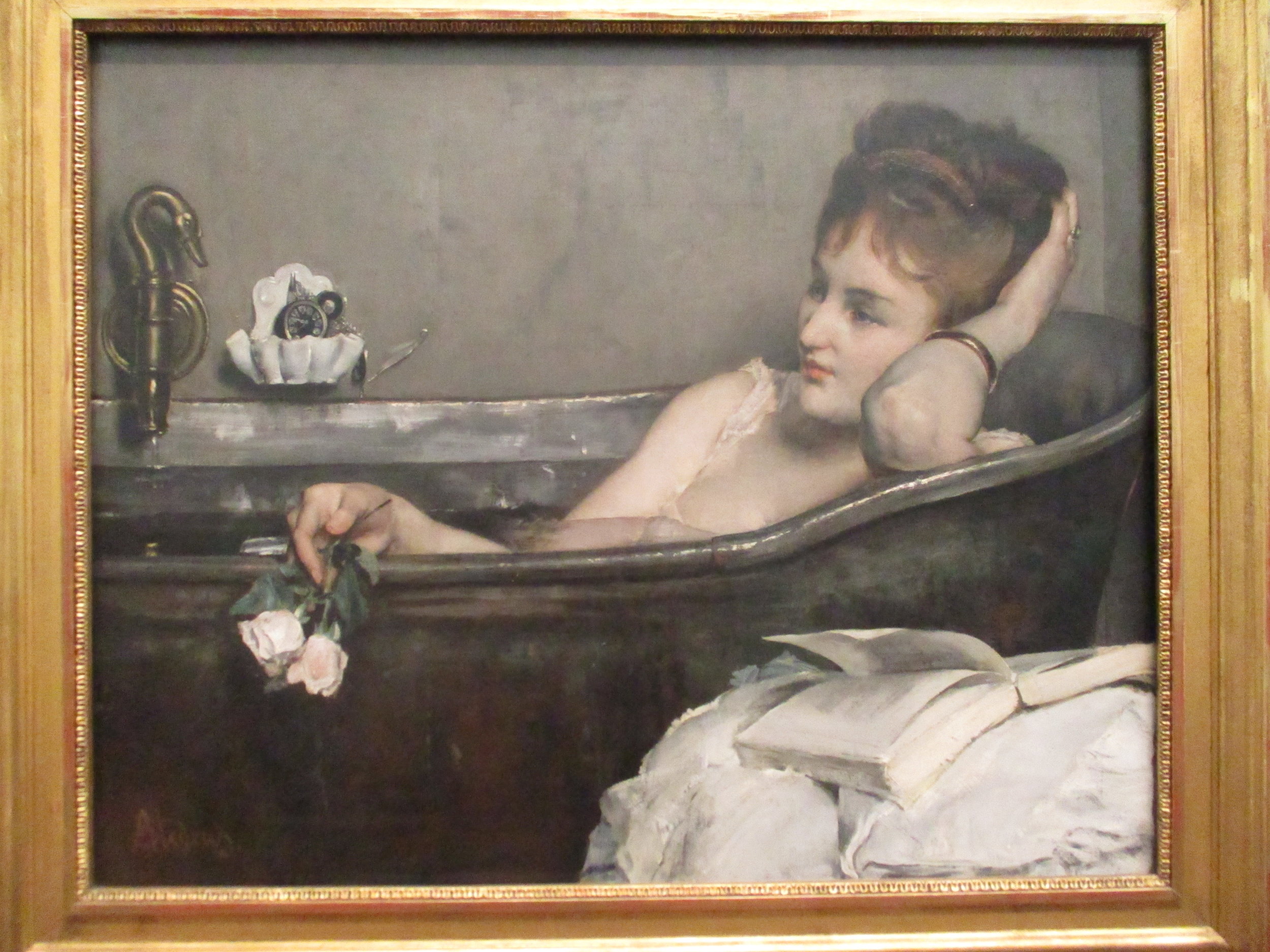I was absolutely thrilled yesterday to see Stevens's 'The Bath' 1867 in the flesh, so to speak at the Art Gallery of South Australia's 'Colours of Impressionism' exhibition.
https://www.artgallery.sa.gov.au/agsa/home/Exhibitions/NowShowing/Colours_of_Impressionism
This is a painting I've only seen in reproduction and it was the crux of a chapter I wrote in my first book, the edited anthology 'Domestic Interiors: Representing Homes From the Victorians to the Moderns' Bloomsbury 2013. In this book I considered the history in art of each room in a house.
Selecting the bathroom for myself -- [an obscure passion for plumbing] its titled "Bathrooms: Plumbing the Canon: the bath tub nudes of Alfred Stevens, Edgar Degas, and Pierre Bonnard".
Here's what I wrote:
'Alfred Stevens’s The Bath shows us a full-length French zinc tub filled to the brim. The Bath (see Figure 7.2) is a departure for Stevens, whose subjects are usually seen fully dressed in lavish interiors. Known for his paintings of Paris’s fashionable women, Stevens was interested in psychological interiority, and often caught his subjects in moments of frustration, boredom or longing. His were contemporary women, who liked precious objects and dwelt in luxuriously decorated salons or boudoirs. He painted both society women and cocottes or demi-mondaines , femmes both fragile and fatale, and his approach was sensitive and objective, sensual and almost documentary in style, leaving clues for his fashion-conscious audiences to pick up on—subtle narrative threads laid down in details of dress, décor, and pose. The woman in Stevens’s The Bath is in a state of interiority that is palpable, an idea conveyed by the novel placed half-finished on a stand by the bath (she has been doubly immersed, in bath water and text). But she has put the novel down, perhaps either because her reading has triggered a memory or because she’s been too distracted to concentrate on it. The water in the bath is clear (more on that later) and still, as might be expected from a scene in which the bather in a state of motionless reflection. She touches her left hand to the back of her head, and her facial expression is dreamy and absorbed as the warm water envelopes her and creates a Freudian sense of oceanic boundarylessness.
The white roses she holds in her right hand dangle over the edge of the tub and could be viewed as symbols of love and beauty; furthermore, the fact that there are two blooms evokes notions of being part of a pair, and the fact that she holds them pointing heads down indicated to knowing audiences that she is indeed ‘off the market’. The bath tap, in the shape of a swan’s head, is based on a classic Roman design that is still popular and available today from plumbing suppliers. The inclusion of the swan-shaped tap also refers to the classical myth of Leda and heightens the erotic subtext in the painting. The bathing woman wears the gold bracelet of the successful artist’s model, and her red hair, distinctive facial features and known friendship with Stevens suggests the model may have been Victorine Meurent, the model Manet used for his Olympia in 1863 and whom Picasso used for his Celestine in the 1900s.
The viewing dynamic Stevens established here locates the viewer as a desiring heterosexual male lover, placed at an almost intrusively intimate nearness to her. The Bath operates in a manner not unlike another work of that time, Fantin-Latour’s Woman Reading . Of this picture, Michael Fried has written that it functions within an absorptive framework and tradition. In this framework, the preoccupied face of the sitter is composed in such a way that our role as beholders is denied; a proposal is being constructed (through a range of conventions or effets de real ) that suggests that the scene before us is ‘real’ and that there are no barriers in our observational relationship with the sitter. We observe her state of mind in a manner that is as natural and as unmediated as it might be in real life, while at the same time appreciating this ‘effect’ as it has been mastered by the artist (Fried 1992: 52).
Here Stevens has turned the bathroom into a cloister, and the dreamy meditations of this bather have been encouraged by her access to endless hot running water. That she has been meditating for some time is gently underscored by the fob watch in the soap holder in the centre of the picture. Social historian Michael Adcock makes the astute point that the bathroom is now aspiring to the status of the boudoir. Moreover, for the first time, bathing could become a regular rather than an occasional occurrence, and the bathroom began to change form from being the site of rather awkward and makeshift ablutions to being a place of stylishness and comfort . . . The bathroom was now a place to tarry and to relax, and has taken on some of the intimate and romantic connotations of the boudoir. (Adcock 1996: 34)'
On seeing it in the flesh? Its bigger and more bravura than I imagined; the tones on the elbow and cheek are extraordinary; the swan on the tap has a more lecherous expression that even the largest file size images can convey, and overall its gorgeous. Kudos to the Musee d'Orsay for sending it as far as Adelaide.

